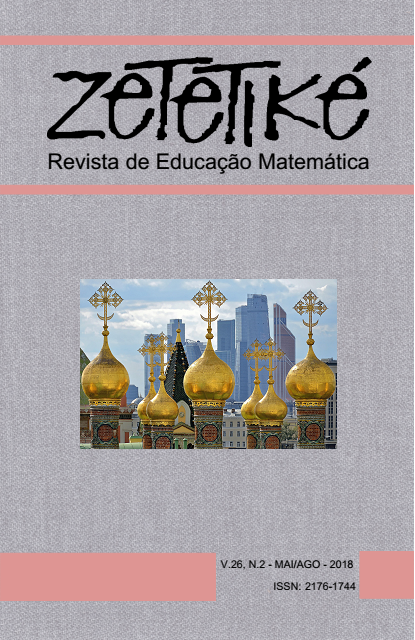Resumo
Neste artigo discutimos a construção do conhecimento conceptual dos números racionais, por alunos do 3.º e 4.º ano do ensino básico, como processo integrado em que se privilegia a percentagem. Pretendemos perceber, numa etapa inicial da aprendizagem dos números racionais, que compreensão constroem os alunos da natureza relacional da percentagem e de que modo a percentagem contribui para essa aprendizagem, considerando uma compreensão das relações entre as diferentes representações os números racionais. Este estudo tem por base uma experiência de ensino, seguindo uma metodologia de Investigação Baseada em Design. Os dados foram recolhidos através da observação participante, apoiada num diário de bordo, e de gravações áudio e vídeo das aulas, sendo analisados os diálogos e as produções dos alunos de uma turma. Os resultados evidenciam que os alunos mostram compreender a natureza relacional da percentagem e que a compreensão das relações e conceitos envolvidos na noção de percentagem contribuem para a construção de um entendimento da natureza multiplicativa dos números racionais.
Referências
Behr, M., Lesh, R., Post, T., & Silver, E. (1983). Rational number concepts. In R. Lesh & M. Landau (Eds.), Acquisition of mathematics concepts and processes (pp. 91–126). New York, NY: Academic Press.
Behr, M. J., Lesh, R., & Post, T. (1981, April). Rational number ideas and the role of representational systems. Paper presented at the Annual Meeting of the American Educational Research Association, Los Angeles, USA.
Bruner, J. (1996). Cultura da educação. Lisboa: Edições 70.
Cobb, P., Stephan, M., McClain, K., & Gravemeijer, K. (2001). Participating in classroom mathematical practices. In E. Yackel, K. Gravemeijer & A. Sfard (Eds.), A journey in mathematics education research: Insights from the work of Paul Cobb (pp. 117–163). New York, NY: Springer.
De Corte, E., Depaepe, F., Op’t Eynde, P., & Verschaffel, L. (2005, January). Comparing mathematics education traditions in four European countries: The case of the teaching of percentages in the primary school. Paper presented at the meeting of Universiti Teknologi Malaysia, Malaysia.
Dreyfus, T. (1999). Why Johnny can’t prove. In D. Tirosh (Ed.), Forms of mathematical knowledge (pp. 85–109). Dordrecht: Springer.
Freudenthal, H. (1968). Why to teach mathematics so as to be useful. Educational Studies in Mathematics, 1(1), 3–8.
Goetz, J. P., & LeCompte, M. D. (1984). Ethnography and qualitative design in educational research. New York, NY: Academic Press.
Goldin, G. A., & Kaput, J. J. (1996). A joint perspective on the idea of representation in learning and doing mathematics. In L. Steffe, P. Nesher, P. Cobb, G. A. Goldin, & B. Greer (Eds.), Theories of mathematical learning (pp. 397–430). Hillsdale, NJ: Eribaum.
Gravemeijer, K., & Cobb, P. (2006). Design research from the learning design perspective. In van den Akker, K. Gravemeijer, S. McKenney, & N. Nieveen (Eds.), Educational Design Research (pp. 45–85). London: Routledge.
Hiebert, J., & Lefevre, P. (1986). Conceptual and procedural knowledge in mathematics: An introductory analysis. In J. Hiebert (Ed.), Conceptual and procedural knowledge: The case of mathematics (pp. 1-27). Hillsdale, NJ: Erlbaum.
Hiebert, J., Wearne, D., & Taber, S. (1991). Fourth graders' gradual construction of decimal fractions during instruction using different physical representations. The Elementary School Journal, 91(4), 321–341.
Lamon, S. (2007) Rational numbers and proportional reasoning. In F. Lester (Ed), Second handbook of mathematics teaching and learning (pp. 629–667). Greenwich, CT: Information Age.
Leinhardt, G. (1988). Getting to know: Tracing students’ mathematical knowledge from intuition to competence. Educational Psychologist, 23(2), 119–144.
Lembke, L. O, & Reys, B. J. (1994). The development of, and interaction between, intuitive and school-taught ideas about percent. Journal for Research in Mathematics Education, 25(3), 237–259.
Moss, J. (2002). Percents and proportion at the center: Altering the teaching sequence for rational number. In B. Littweiller (Ed.), Making sense of fractions, ratios, and proportions (pp. 109–120). Reston, VA: National Council of Teachers of Mathematics.
Moss, J., & Case, R. (1999). Developing children’s understanding of the rational numbers: A new model and an experimental curriculum. Journal for Research in Mathematics Education, 30(2), 122–147.
NCTM (2000). Principles and standards for school mathematics. Reston, VA: National Council of Teachers of Mathematics.
Parker, M. (2004). Reasoning and working proportionally with percent. Mathematics Teaching in the Middle School, 9(6), 326–330.
Parker, M., & Leinhardt, G. (1995). Percent: A privileged proportion. Review of Educational Research, 65(4), 421–481.
Ponte, J. P. (2005). Gestão Curricular em Matemática. In GTI (Ed..), O professor e o desenvolvimento curricular (pp.11–34). Lisboa: APM.
Ponte, J. P., Carvalho, R., Mata-Pereira, J., & Quaresma, M. (2016). Investigação baseada em design para compreender e melhorar as práticas educativas. Quadrante, 25(2), 77–98.
Ponte, J. P., & Serrazina, M. L. (2000). Didáctica da Matemática do 1.º ciclo. Lisboa: Universidade Aberta.
Serrazina, M. L. (2012). O sentido do número no 1º ciclo: Uma leitura de investigação. Boletim Gepem, 61, 15–28.
Siegler, R. S. (2016). Magnitude knowledge: The common core of numerical development. Developmental Science, 19(3), 341–361.
Siegler, R. S., Fazio, L. K., Bailey, D. H., & Zhou, X. (2013). Fractions: The new frontier for theories of numerical development. Trends in Cognitive Sciences, 17(1), 13–19.
Siegler, R. S., Thompson, C. A., & Schneider, M. (2011). An integrated theory of whole number and fractions development. Cognitive Psychology, 62(4), 273–296.
Tian, J., & Siegler, R. S. (2017). Which type of rational numbers should students learn first?. Educational Psychology Review, 1–22.
Van den Heuvel-Panhuizen, M. (2003). The didactical use of models in realistic mathematics education: An example from a longitudinal trajectory on percentage. Educational Studies in Mathematics, 54(1), 9–35.
Van Galen, F., Feijs, E., Figueiredo, N., Gravemeijer, K., Herpen, E., & Keijzer, R. (2008). Fractions, percentages, decimals and proportions: A learning-teaching trajectory for grade 4, 5 and 6. Rotterdam: Sense.
Van Galen, F., & Van Eerde, D. (2013). Solving problems with the percentage bar. Indonesian Mathematical Society Journal on Mathematics Education, 4(1), 1–8.

Este trabalho está licenciado sob uma licença Creative Commons Attribution-NonCommercial-NoDerivatives 4.0 International License.
Copyright (c) 2018 Zetetike


